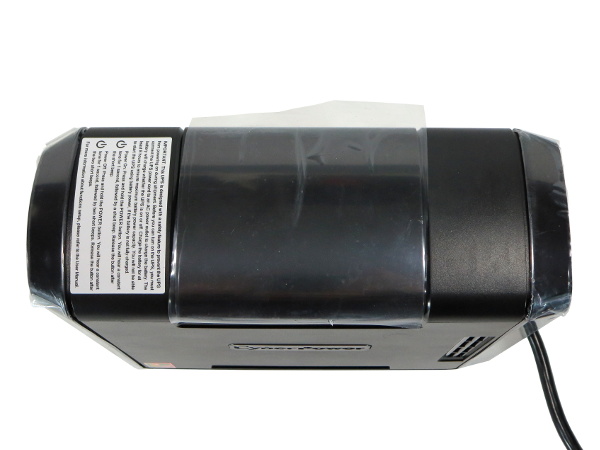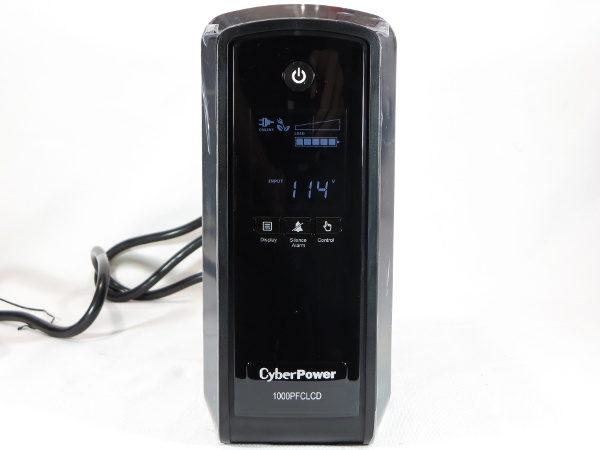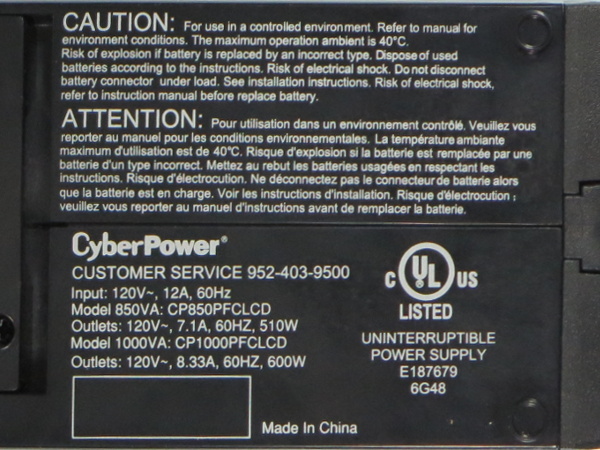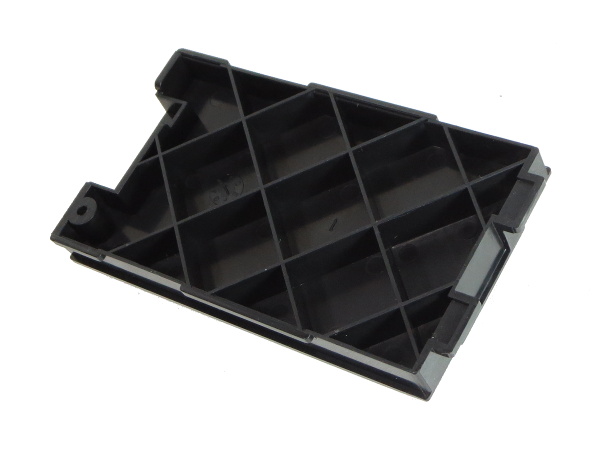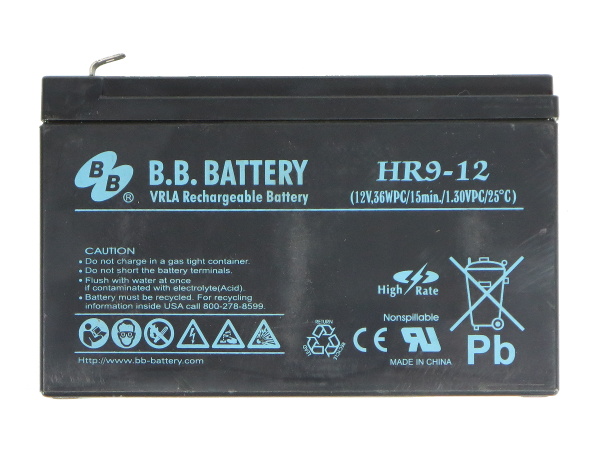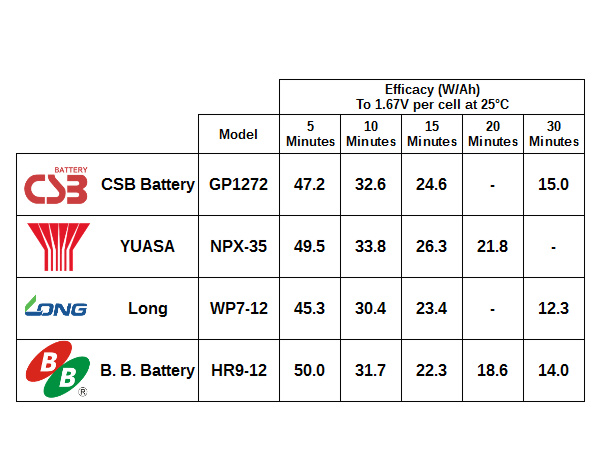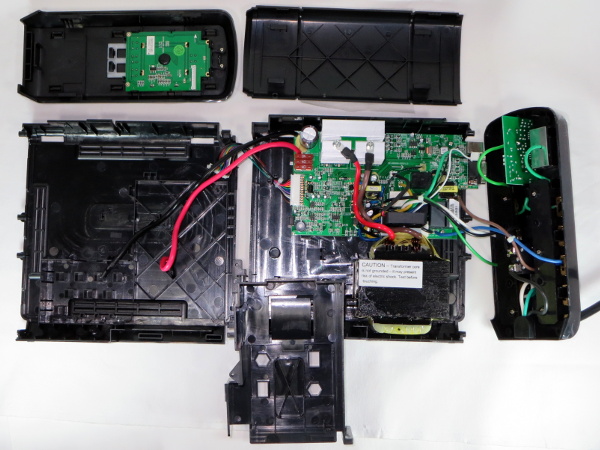CyberPower CP1000PFCLCD Tear-Down
Top
There's not much to see in this shot except the same initial power-up instructions that were present on the LX1500. There is one interesting difference though: while the LX1500’s enclosure consisted of two halves snapped together at the top, forming a seam along the middle, the 1000PFCLCD’s top piece slides towards the back to release both side panels and the front after the rear cover is removed.
Also unlike the LX1500, the 1000’s power-up label is a thin plastic affair instead of a metallic label with a strong plastic backing, lending additional credibility to my suspicion that the label was indeed structural on the LX1500.
Front
Remember my comments about how the LX1500 could have used one extra button to make configuration easier? The 1000PFCLCD has two extras adorning its glossy black front panel: one to toggle the alarm function and another to access controls. Ironically though, configuration options are limited to line voltage sensitivity only.
On the LX1500, all the basic configuration parameters are accessible through its tedious one-button interface. One step forward, two steps back.
Bottom
The bottom face of the unit is home to the battery door, product information, warnings and miscellaneous other information as usual. I believe this is the first time I have seen a battery door that opens by sliding inward instead of outward.
Printed on the battery door is a mention of patent 7405544. Are you at least a little bit curious to find out what it is about?
Patenting The Obvious
Is that an auto-transformer with some switches or relays to select taps or bypass the transformer altogether? This is fundamentally how tap changers work, and mechanical tap changers have been around for over half a century in power distribution networks. Also, as documented in this patent, Cyber’s AVR would only be capable of boost operation. My old APC BX1000 did buck-boost AVR while leaving its transformer disconnected when not in use (that second part is “GreenPower” in CyberPower-speak) and its main board was manufactured in 2005, one year before CyberPower filed this patent.
Get Tom's Hardware's best news and in-depth reviews, straight to your inbox.
Indentity Crisis
In the caution department, I believe this is the first time I have seen an explosion warning about using the incorrect battery type. Different batteries use different form factors to make accidental mix-ups unlikely. Much like APC, CP uses the same enclosure for its 850VA and 1000VA models, and chose to use the same silkscreen with information for both. On paper, the only obvious material difference between the 850VA and 1000VA versions is the battery: 8Ah versus 9Ah.
I’m guessing the blank area framed with a white square was intended for a serial number print or sticker that got omitted for whatever reason.
Battery Door
In my LX1500 story, I had an issue with a broken flimsy tab on the battery door and wrote that CyberPower should have used two thicker tabs instead. In the 1000PFCLCD, it looks like the company got the right general idea. On the other hand, the lips that slide behind the side panels to lock the door in place do not seem like they would survive a hard landing. These should have been a little wider to prevent them from popping out if the sides bow out a little, and thicker to make them less likely snap and reinforce the battery door’s sides.
BBBBBattery!
What lies behind that door? The B. B. Battery HR9-12 is a high-performance absorbed glass mat (AGM) valve-regulated lead-acid battery (VRLA) designed specifically for high drain applications like a UPS. As such, it features an internal resistance of less than 15mΩ when fully charged and a five-second burst current rating of 120A.
Battery Shoot-Out
How does the HR9-12 compare? Instead of hunting down other 9Ah competitors, I chose to switch numbers around and normalize the power rating for a given discharge time per Ah of nominal capacity. Since the BBB lacked ratings for 1.67V (which all of the other batteries are rated at), I used a linear interpolation between 1.6V and 1.7V for BBB.
The BBB unit leads the five-minute discharge race by a hair, then jockeys for third place with Long for all other rates, while CSB splits the distance between third place and Yuasa in the lead. I’d call this a clear victory for Yuasa, a firm second-place finish for CSB and a mixed bag for Long and BBB.
Simple Puzzle
Taking the UPS apart is simple enough: remove the battery door to reveal a hidden screw fastening the top cover to the battery cradle, remove the rear cover’s screws, slide the top cover towards the rear to unlock the front cover, slide the front cover down to unhitch it from the side panels and reveal another screw also fastening the top cover to the battery cradle, gently pry the top cover and off it comes. Getting the battery cradle to separate from the bottom cover takes a substantial amount of force to release its snaps.
Great, Another One
Power conductors in the 1000PFCLCD are crimped and soldered to the motherboard, just like they were in the SMART1000.
MORE: APC BE550G Tear-Down
MORE: Tripp-Lite SMART1000LCD Tear-Down
MORE: CyberPower LX1500GU-FC UPS Tear-Down
-
KaiserPhantasma inally =D but will these get a "ok to buy" from you or are there other models/brands we can look at?Reply
also well written nice job on the article -
Daniel Sauvageau Aside from Tripp-Lite which gets a definitive fail for lacking a breaker and wasting twice as much power as almost any other UPS I have taken apart here, they are all "worth looking at" if they suit your specific application.Reply
I'm using the LX1500 for my main PC (not using the coax nor Ethernet protections), I installed the BE550 at my mother's place as planned and I'm currently using the 1000PFCLCD as a portable/isolated AC source.
None of them are perfect but they are all usable. There is that nagging feeling from seeing third or fourth tier caps peppered throughout most of them. Higher quality caps appear to have gone extinct in UPS under ~$160. At least those I have gotten my hands on so far. -
cage0022 I enjoy your reviews, but this was so technical, I'm not even sure if this is a positive review or not. So are you saying it doesn't really do sine wave and if buying for that factor, it's a waste of money?Reply
Lastly, what would you recommend for someone who wants a good sinewave UPS that also offers good surge protection, without breaking the bank? (or, what's the most affordable way to get a good surge protector and battery backup unit?) -
Daniel Sauvageau Reply
It is a tear down, I show you what is inside, comment on some of the things I have seen and readers can decide if what they have seen is worth whatever the unit or an equivalent one might be worth to them. The PFCLCD did produce a (mostly) sinusoidal output but on my unit, the output voltage under no-load condition was intermittently extremely low the first few times I checked. An UPS would not normally run under no-load condition, so that shouldn't be an issue during normal use.18256861 said:I enjoy your reviews, but this was so technical, I'm not even sure if this is a positive review or not.
Where surge protection in UPSes is concerned, none of those I have looked at here so far have anything beyond basic three MOVs surge protection on the power side, the same protection found in the same brands' $10-15 power strips. If you want more thorough power line surge protection, you will need to disregard the UPS and surge protector instructions and use something else with more serious surge protection (isobar, SurgeArrest Performance, SurgeX/Zerosurge, etc.) upstream from the UPS.
-
falchard Actually for a Coax cable you want the dielectric just a bit past the fitting's edge. Depending on how cheap the fitting is, it may need to be a little longer. Still that coax cable is junk and running a coax through the UPS will probably ruin a digital signal. Better to ground out a coax cable at the MPOE instead of through a surge protector.Reply -
cage0022 Reply18258292 said:18256861 said:I enjoy your reviews, but this was so technical, I'm not even sure if this is a positive review or not.
If you want more thorough power line surge protection, you will need to disregard the UPS and surge protector instructions and use something else with more serious surge protection (isobar, SurgeArrest Performance, SurgeX/Zerosurge, etc.) upstream from the UPS.
Thank you for the clarification on the sinewave issue. Where you state, "disregard the UPS and surge protector instructions and use something else with more serious surge protection (isobar, SurgeArrest Performance, SurgeX/Zerosurge, etc.) upstream from the UPS", is that safe to do? I thought I'd read somewhere that you shouldn't plug a UPS into a surge protector (or vise versa). If so, that's what's lead to my quandary - if you shouldn't plug a UPS into a surge protector, then how does when get surge and battery backup?
Also, thank you for the teardowns - although I may not understand the technical side, it's still a great read and good to see someone separating the marketing from the truth.
-
Daniel Sauvageau Reply
Indications against it are stuck on labels, printed or molded into just about every UPS and power strip I have taken apart here. There are two reasons I can think of: not overloading the power bar (which you shouldn't be able to do on a good bar with #14 cord and a 15A breaker in the first place) and poor/intermittent ground connections on those cheap bars or UPS that use simple flaps for the ground connections like the BE550 from last month.18259735 said:is that safe to do? I thought I'd read somewhere that you shouldn't plug a UPS into a surge protector (or vise versa).
Of those two issues, I'd say poor ground is the one that bothers me the most as those square-bent flap-style ground connections are still common despite the more reliable torque contact style (I call them 'torque' because the contact fingers attach to the sides of the metal strips which act as torque bars and reduce strain at bend lines) costing practically the same to manufacture: one slightly more complex cutting die, one slightly more complex bending/shaping die, same amount of metal. (Though based on the level of inconsistency in how flaps get bent, I would not be surprised if they got 'shaped' by poking blunt nails in assembled units instead of a die.)
Every extra cord and junction box between the breaker box and your loads is one more potential point of failure and extra power losses. There is nothing fundamentally wrong with combining devices within reason but manufacturers don't want to take the blame if people exaggerate and something goes wrong.
I believe the only power bar I have seen that lacked such instructions is the SurgeX's SA-1810. That thing is built like a tank, which does not leave much for the company to worry about. I would expect no less from a $200+ surge protector and its instructions even suggest protecting UPSes as one application. -
gamebrigada I would love to see you tear down some "Enterprise" grade UPS's. Some that have some serious reliability and where name brands are paid extra for. I would do one myself out of curiosity but I doubt my opinion would be regarded well.Reply -
jeyman Dan,Reply
I wanted to say that your review is very thorough and well put together. I gained a lot of insight about the Cyberpower units and how they are built (as well as their shortcomings). Thank you for that.
A few things to consider though. Your writing style sometimes comes across as overly sarcastic and you make a presumption that the reader has already gone through your previous articles, leaving off key details or making inferences. Additionally, your readers could benefit from a well formed summary or conclusion as we do not all possess the skill sets that you do. With your attention to detail and obvious subject knowledge, I think your articles could be made even better with a little more time and care.
I look forward to seeing many more of your articles and will make a point to check out your previous postings.
Thanks again for the good read.
